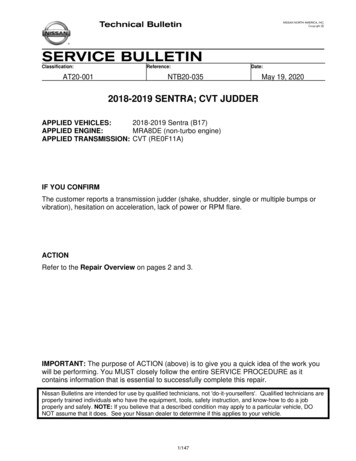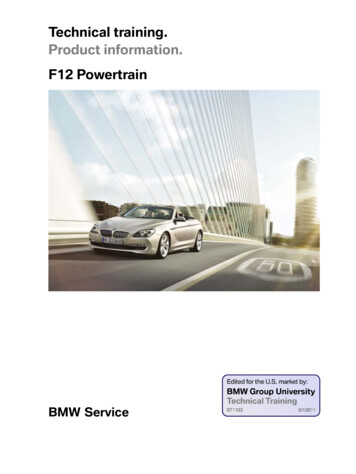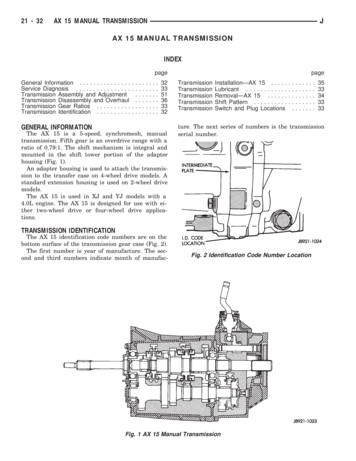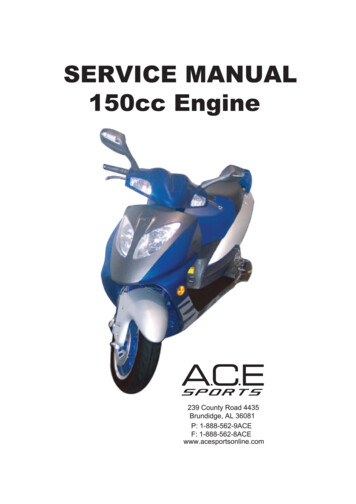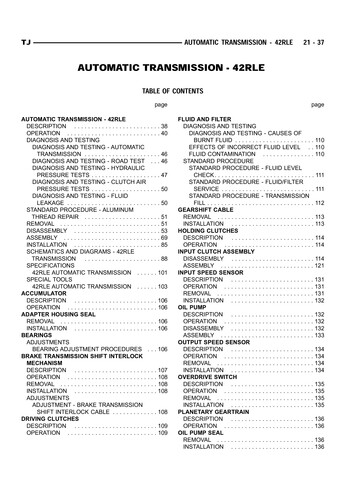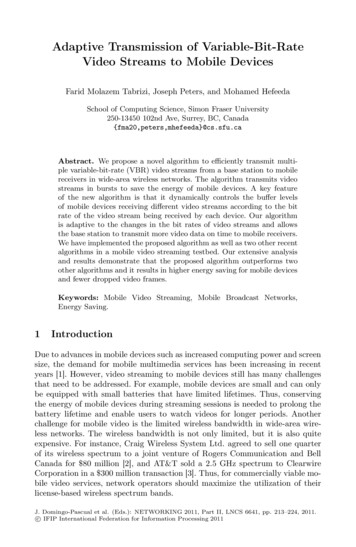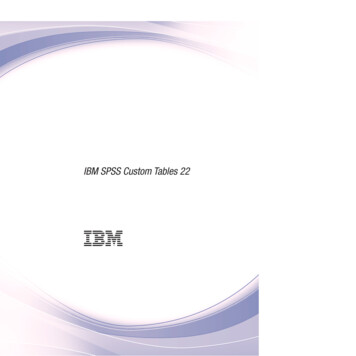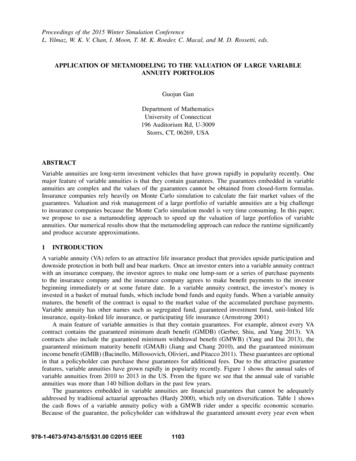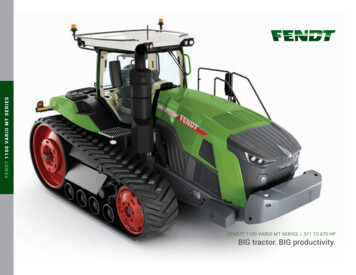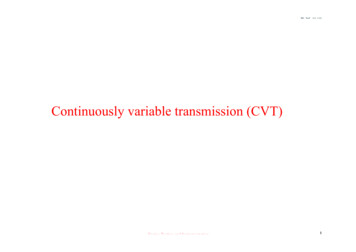
Transcription
Continuously variable transmission (CVT)Engine Testing and Instrumentation1
CVT CVT allows for the operation at the lowest possible speed and highest possibleload, partially avoiding the low efficiency region of the engine map. A continuously variable transmission (CVT) transfers power through a rangeof speed/torque ratios from engine input to output, continuously withoutinterruption Contrast with either manual or conventional automatic transmissions that usediscrete ratios and normally disengage when changing ratio The CVT category includes infinitely variable transmissions (IVT) that give azero output speed within the operating rangeEngine Testing and Instrumentation2
Simple Friction DriveLow Output Speed(Low gear selected)Constant input speedEngine driveninput shaft drivesdisc with frictionsurfaceOutput shaftconnects to wheelsEngine Testing and Instrumentation3
Friction Drive: High SpeedHigh output speed(top gear, high ratio)Constant input speedMovement betweenratios takes placewithout steps andgives a continuouschange of ratioEngine Testing and Instrumentation4
Friction Drive: Zero OutputGeared Neutral with input rotating gives IVTZero output speed whendisc moved toline up with centre ofrotation of input shaftConstant input speedReverse output speedpossible if output discmoved below inputcentre lineEngine Testing and Instrumentation5
Vehicle Layoutb - Input discc - Output discEngine Testing and Instrumentation6
Disc Friction Drive CVTFIRST CAR: Tenting,France 1891GWK of Maidenhead1910-1931, two seat cyclecarsEngine Testing and Instrumentation7
CVT Categories & Targets Successful CVT will resolve the compromises in reliability, durability,efficiency, and controllability with low cost Implementation of commercially produced CVTs transmit drive throughfriction Variable pulleys with flexible belt or chain– sliding friction Traction drives with rotating surfaces– rolling contact, shear frictionEngine Testing and Instrumentation8
Variable Pulley Variable pulley systems are based on the common v-belt pulley fixed ratiolayout with power transfer through a flexible element connecting between twopairs of pulley sheaves. Flexible element may be a belt or chain Sheave movement usually controlled by hydraulic or electrical meansEngine Testing and Instrumentation9
Variable Pulley DriveConstant input speedSmall radius offlexible beltLow RatioLarge radius offlexible belt resultsin slower speedEngine Testing and Instrumentation10
Mid Ratio: Speed 1:1FIXEDSIDEFIXEDSIDEEngine Testing and Instrumentation11
DAF Variomatic Rubber V-BeltsEngine Testing and Instrumentation Introduction in 1958 Over 1 million DAF and Volvocars produced in 20 yearperiod Shown is DAF 55 drive usedwith 1100 cc Renault enginefrom 196812
Metal V-Belt ConstructionIntroduced by Van Doorne’s Transmissie in 1987Engine Testing and Instrumentation13
Metal V-Belt Transmission Production from 19872000 about 3 million In the last 4 years about4.5 million produced Example shown is a ZF–CFT23 with torqueconverter inputEngine Testing and Instrumentation14
Vehicle applications forBosch-VDT Belt in 2004Engine Testing and Instrumentation15
LuK/PIV-Reimers chain Audi MultitronicEngine Testing and Instrumentation16
Traction Drives Many physical alternative layouts that give the mechanical geometry changessuitable to give a CVT. “Traction” requires transmission through a fluid film under elastohydrodynamic lubrication (EHL) conditions.Engine Testing and Instrumentation17
The Toroidal Drive ConceptEngine Testing and Instrumentation18
Half Toroid ConstructionEngine Testing and Instrumentation19
Jatco/ NSK Half Toroid Fitted as production item in Nissan Gloria and Cedric from 1999, home marketonly 3 L petrol engine Input rating 210 kW, and 390 Nm CVT ratio range 4.4:1 Torque converter as a starting device Model upgrade in 2004Engine Testing and Instrumentation20
Full ToroidHunt PatentHayes VariatorEngine Testing and Instrumentation21
Full Toroid TransmissionAustin 161932Engine Testing and Instrumentation22
Torotrak IVT LayoutTorotrak use a“split path” layoutwith an epicyclicgear on the outputside. This gives ageared neutral andhence infinite ratioand also a reverse,hence is an IVT.Engine Testing and Instrumentation23
Torotrak IVT In-line TransmissionEngine Testing and Instrumentation24
CVT Benefits No gear shift Continuous transmission of torque Control of engine speed independently of vehicle speed Ability to operate engine at peak power over wider range of vehicle speeds Ability to operate at most fuel efficient point for required output powerEngine Testing and Instrumentation25
Control Objectives Good fuel economy Good driver feel – driveability Easy driving as an automatic Comfort and smoothness for passengers Performance – acceleration capability Electronic control enables theseEngine Testing and Instrumentation26
Williams (FW 15C) Van Doorne LG1 Power: 600 kWInput speed: 15 000 rev/minInput torque: 600 NmRatio range: 2.5:1Pulley centres: 160 mmFIA ban: 1993Engine Testing and Instrumentation27
ManualTiptronicVehicle speed [km/h]Engine speed [rev/min]Acceleration Comparisons: Porsche BoxsterCVTip in DEngine Testing and Instrumentation28
CVT Disadvantages Mechanical efficiency of variator Parasitic efficiency of transmission system and controller Compromise between fuel economy and torque margin to achieve driveability(avoid elastic band feel)Engine Testing and Instrumentation29
CVT Efficiency All CVT variators have losses due to the power transfer which appears as aspeed or slip loss across the variator CVTs are hydraulically controlled and the pump takes power as in aconventional automatic transmission Efficiency is more variable for CVT than geared discrete ratio systemsEngine Testing and Instrumentation30
Engine mapGood fuel economyWOT- wide open throttle(maximum torque line)IOL – ideal operating line,gives best economy forCVT operationWide ratio range needed toachieve ideal engine operationEngine Testing and Instrumentation31
Fuel Consumption FiguresComparison of fuel consumption figures for CVT relative to equivalent automatics shows a5-10% improvement for 4 to 5 ratio variants.However, the table shows comparison for equivalent manual transmission vehicles over theEuropean Drive Cycle ( ve in red is d13.2%16.4%8.3%1.7%4.9%4.9%-2.3%0.0Engine Testing and Instrumentation32
Driveability Compromise Driveability describes the longitudinal dynamic behaviour of a vehicle inresponse to driver inputs, in a comprehensive range of driving situations, andthe related driver subjective perception of that behaviour Less torque available immediately with a CVT than with a gear transmissionEngine Testing and Instrumentation33
Driveability CompromiseGood fuel economyWOT- wide open throttle(maximum torque line)IOL – ideal operating line,gives best economy forCVT operationTorquemarginEngine Testing and Instrumentation34
Solutions for Improved Driveability Torque boosters– flywheel– integrated electrical machine (motor/generator) Control – modified calibration Match the CVT with the most appropriate engine Modify engine characteristics to those of the transmission by design and/orcontrolEngine Testing and Instrumentation35
Zero Inertia ConceptEngine Testing and Instrumentation36
CVT Mild Hybrid ArchitectureDC/DCConverter EMInverterControl CurrentBattery-CVT or ratorCAN BusEngine Testing and Instrumentation37
Engine Matching Diesel engines have higher torque and lower speed range than petrol Modify engine systems to develop higher torque at low speeds – interest in thisas engine downsizing for conventional transmissions too Use of lean burn techniques to operate engine more efficiently at higher speeds– experimental studies have shown both improvement in steady fuelconsumption and transient response Development of homogeneous charge compression ignition (HCCI) andcontrolled auto ignition (CAI) is also appropriate for CVTsEngine Testing and Instrumentation38
Market Share in 2004RegionManualAutomaticCVTEurope84%14%2%N. America9%90%1%Asia40%52%8%Japan20%65%15%Engine Testing and Instrumentation39
Market Predictions ZF – increase from 2% share of sales in 2002 to 4.4% in 2012 ZF – CVT will occupy 10 % of market for automatic transmissions in 10 years Jatco – increase from 8% share of sales in 2003 to 45% by 2010 CSM Worldwide – increase in N. America to 3% by 2009Engine Testing and Instrumentation40
Comments CVT has a bright futureMarket share increasingResearch and development still required– Improve efficiency– Torque booster– Engine integration– System control CVT driveability is key to customer acceptance, particularly inEuropeCVTs share some driveability characteristics with hybrid vehiclesControl and calibration with new concepts and an integratedapproach to total powertrain calibration can give driveabilitysolutions Engine Testing and Instrumentation41
A continuously variable transmission (CVT) transfers power through a range of speed/torque ratios from engine input to output, continuously without interruption Contrast with either manual or conventional automatic transmissions that use discrete ratios and normally disengage when changing ratio
